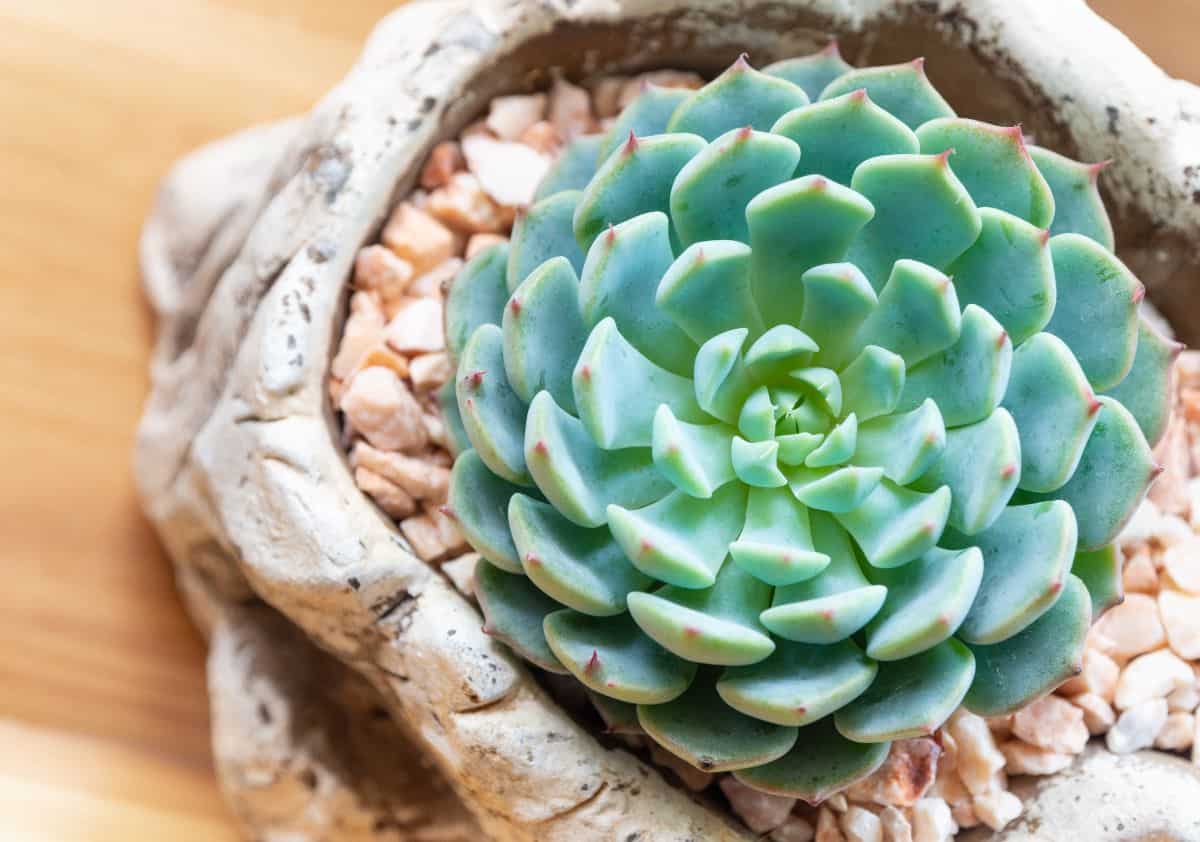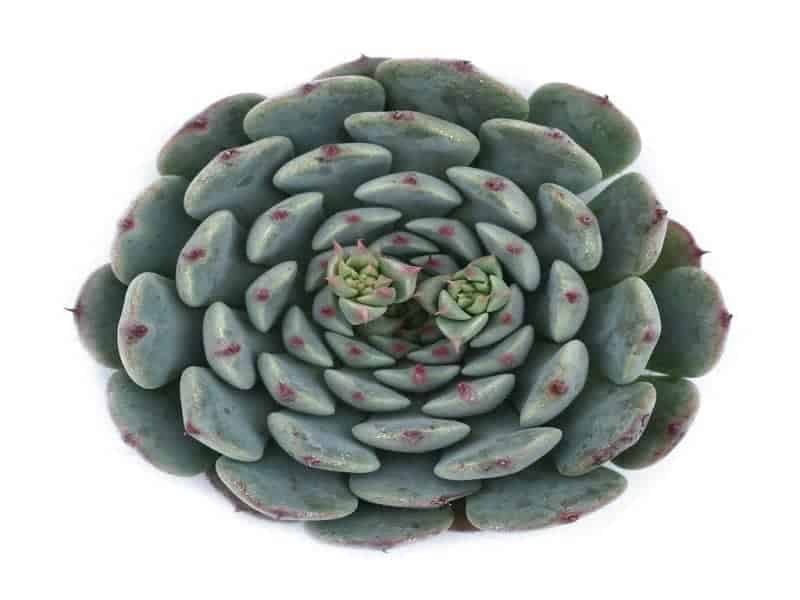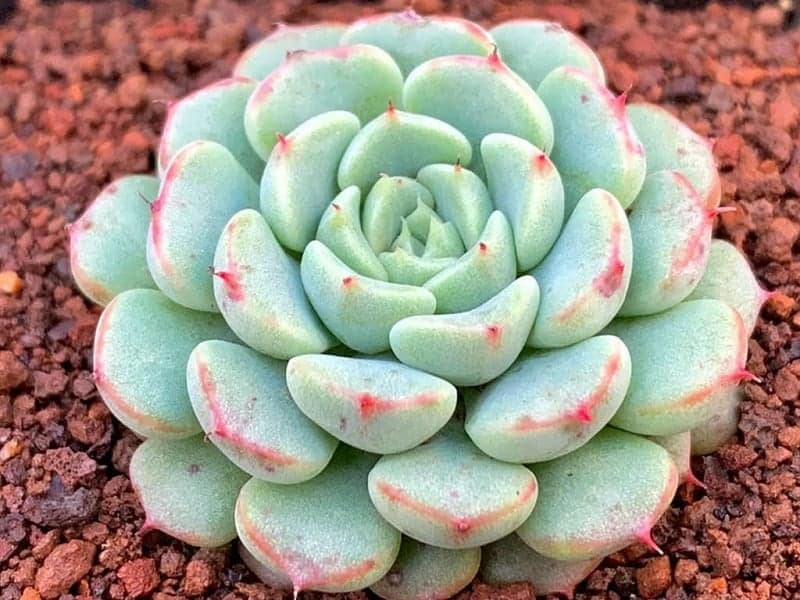Echeveria minima is a petite succulent native to Mexico. It’s a popular succulent among growers because of its small size at maturity. For this reason, it’s a great choice for indoor gardens with limited space, as well as projects like fairy gardens or living wreaths.

Jump to:
Echeveria minima Appearance
| Name: | Echeveria minima |
| Soil: | Well-draining soil |
| Blooming: | Late Spring |
| Light: | Indirect light to partial shade |
| Water: | When the soil is completely dry |
| Propagation: | Cuttings, offsets and seeds |
Echeveria minima is a small, rosette-shaped succulent with densely packed leaves. The leaves are grayish-green in color with definitive points. The leaf margins have a reddish hue to them. The rosette of this succulent is so densely packed that generally, only the outer halves of the leaves are visible.

Buy it from:
The red color of the leaf margins is enhanced with increased light levels. Though care should be taken to avoid sunburning Echeveria minima, increased light will result in more vibrant colors brought on by stress.
Echeveria minima blooms in late spring. The flowers of this petite succulent are bell-shaped and yellow and pink in color. They appear atop a long stalk produced at the center of the plant.
Caring for Echeveria minima

Echeveria minima are low-maintenance succulents that are ideal for gardeners of all experience leves. These adorable succulents are also non-toxic to pets, so they’re ideal for pet-friendly succulent collections and outdoor gardens.
Light
No products found.
Echeveria minima enjoys bright, indirect light. An east or west-facing window is ideal, but a south-facing window may also work. This is not a succulent that is tolerant of significant amounts of direct sunlight.
If you live in a climate where you can grow succulents outdoors, be sure to plant your Echeveria minima in an area of partial shade. You’ll also need to use caution during particularly hot weather as this can intensify the effects of direct sunlight.
Direct sunlight can result in sunburn, which is permanent. If your Echeveria gets sunburned, you’ll need to accept its new appearance until the damaged areas are replaced with new growth, or trim away those areas.
Water

As with many other succulents, Echeveria minima is intolerant of overwatering. Too much moisture will result in root rot, so you should always be sure to check the soil before watering.
By inserting your finger into the soil or using a soil moisture meter, you can see if the soil is still moist. If it is, you’ll need to wait a few more days before watering. If the soil is dry, it’s safe to water.
Ideally, Echeveria minima should be watered deeply each time, but the soil should be allowed to dry out between water. Drainage holes are essential in preventing accidental overwatering and root rot.
Temperature
Echeveria minima is not a cold tolerant plant and must be protected from frigid temperatures. Though they are capable of tolerating a light frost, consistently cold temperatures will be a problem.
These delicate succulents also don’t do well in extreme heat, especially in direct sunlight. If they are kept out of direct light and the soil is kept slightly moist, but not wet, they should survive a heatwave just fine.
Soil
Like most succulents, Echeveria minima prefers well-draining soil. In the wild, they grow in the crevices of rocky outcroppings, so gritty soil is essential for drainage. Commercial soil mixes designed for use with succulents and cacti work well, or you can make your own.
Soil with water-retaining ingredients such as clay or peat moss should be avoided. This will result in overly wet soil and the roots of your Echeveria minima will eventually rot. Instead, large particles of coarse sand, gravel, or perlite will promote proper drainage.
Propagating Echeveria minima

Echeveria minima is not a difficult succulent to propagate. They can easily be propagated by separating offsets or using leaf or stem cuttings. It’s also possible to grow them with seeds, though this method requires a patient gardener.
Successful succulent propagation isn’t difficult, but it does require a bit of knowledge and plenty of patience.
Offsets
Since Echeveria minima tends to produce offsets so quickly, this is the easiest method of propagation. Once the offsets are large enough to handle without accidental damage, they can be gently pulled or cut away from the mother plant.
Once the offsets have been separated, it’s best to let them dry out for a few days to let the wounds callous. This prevents the tiny plant from becoming infected by bacteria or fungus through the open wound.
After the wounds have calloused, the offsets can be planted and cared for just as you would a mature Echeveria.
Cuttings

Though not quite as easy as removing offsets, Echeveria minima can also be grown from leaf or stem cuttings. For stem cuttings, typically the top part of the rosette is removed with a sharp, clean knife. Since this plant is so dense, it can be hard to take a stem cutting unless the plant is etiolated.
Leaf cuttings may also be taken with a sharp, clean knife. Generally, it’s recommended to take leaf cuttings from the bottom of the plant.
As with offsets, cuttings should be allowed to dry a few days to callous before planting. During this time, it’s recommended to keep them out of direct sunlight to prevent damage.
Rooting hormone may also be used before planting to help encourage faster root production, but this step isn’t necessary.
Once the cuttings have calloused, they can be planted or set atop fresh soil to await root production.
Seeds
Though it is possible to grow Echeveria minima from seed, this isn’t a common method of propagation. It tends to much more time-consuming than other methods, but it is a fun experiment for the willing and patient gardener.
Seeds can be collected from the flowers of your Echeveria, or you can buy them online. Simply sow the seeds in moist, well-draining soil. The soil should be kept moist and kept in bright, indirect sunlight. After a few weeks, you should begin to see tiny sprouts.
For more information on growing succulents from seeds, check out our guide here.
Sources:
“Secrets to Success when Propagating Succulent Plants.” Michigan State University Extension.


